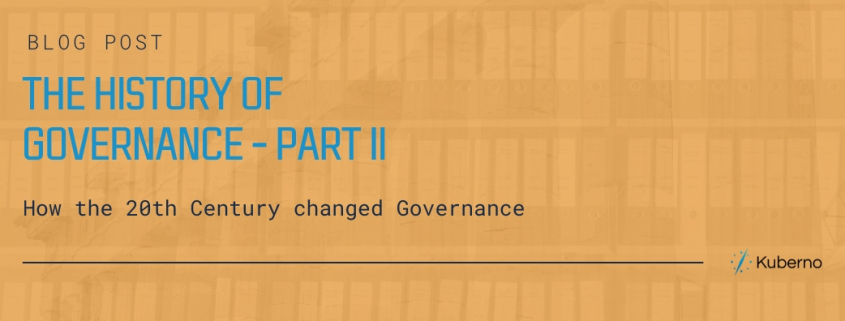The History of Governance – Part 2: How the 20th Century changed Governance
In our last blog, we discussed the origins of the world Governance, the difference between Governance, Leadership and Management and where Governance finds itself today – on the cusp of transformation.
In part 2, we are going to delve deeper into 20th Century history when it comes to Governance.
The Impact of the Industrial Revolution on Governance
Up until the turn of the century, businesses were largely operated on a non-structured basis by individuals or groups of partners with little hands-on operational input. In the US especially, the advent of the railways meant it was no longer possible to run businesses in this way due to the distances and complexity involved. Expertise and authority were needed along the whole length of the railway to deal with local issues promptly.
At the same time, industrial process innovation and mechanisation led to Henry Ford developing the concept of the production line. The production line was about breaking down a complex process of building cars into individual parts and then organising resources (people) to specialise and deliver each individual process. This new system created greater efficiency across the whole. The system was built on command and control – with a clear separation between managers who commanded and controlled, and the workers who did the manual work.
Weber’s Bureaucratic Approach
The concept of the bureaucratic organisation was developed by Max Weber. This was based on the breakdown of tasks and allocation of labour, hierarchical authority, strict rules and requirements, removing personal interactions from the work-place and the concept of long tenure for workers (no need to retrain/reskill) and deep specialisation. The Bureaucratic approach was all about creating the most efficient businesses. This also fitted with the social structures of the time – stricter class barriers and respect driven by hierarchy.
So, bureaucracy became the way businesses’ were structured. And at the same time, the concept of the governance of businesses was born.
How Corporate Governance Came About
It wasn’t until nearly 90 years later, when a series of corporate failures rocked the world, that the concept of corporate governance as a distinct form of governance, was created.
The Cadbury Report – Chaired by Sir Adrian Cadbury and set up by the Financial Reporting Council, London Stock Exchange and the accountancy profession – aimed to restore investor (ie owner) confidence in the UK corporate governance system.
The Code was voluntary and aimed to establish best practice. But the report also emphasised that one size does not fit all and that companies have to choose the optimal governance structures based on their own circumstances.
However, the bureaucratic organisation was still the predominant management philosophy at the time with strict hierarchies and rules around decision making structures. In practice there was little deviation across governance approaches other than number or format of committees and make up of boards.
Indeed, the Cadbury Report defined corporate governance as the system by which companies are directed and CONTROLLED. By giving this definition, they clearly believed that corporate governance should be a bureaucratic form of governance.
Outside of the corporate world, there was a period of significant change – with the advent of the internet and a period of economic boom following a period of recession. This period also saw the rise of globalisation, with the formation of the EU, the break-up of the USSR and opportunities created by internet connectivity.
The Corporate Scandals of the Noughties
The digital age was in full swing during the Noughties. As were corporate scandals such as Enron , Lehman Brothers and the sub-prime mortgage scandal in the US that brought global financial markets to their knees. The response to these scandals was increased regulation and the introduction of individual accountability. The corporate veil that had protected individuals for so long was lifted through Sarbanes Oxley with its focus on individual director accountability for internal control in the US, and the Senior Managers and Certification Regime (SMCR) for the financial services sector in the UK.
The regulatory lens shifted away from a single focus on control and looked elsewhere at culture. Culture was held up as the culprit for many of the scandals, with individual accountability being seen as the panacea.
The FCA saw the SM&CR as an opportunity to set up healthy cultures and effective governance in firms by encouraging greater individual accountability and setting a new standard of personal conduct. Although there were initial issues with this novel scheme, it is now properly implemented and understood, with governance structures designed accordingly and a holistic focus across governance, strategy and culture. It is a real catalyst for change.
This is also the era of the tech giants – Google, Facebook and the Silicon Valley boom of tech startups. These companies were founded by individuals straight out of college who had not yet been tainted by bureaucratic working practices. And with this we started to see different management models emerging.
The Agile Manifesto
The Agile Manifesto was published in 2001 by a group of software developers who knew there had to be a better way to manage software development than a strictly regulated, process driven approach. The manifesto values individuals and interactions over processes and tools, working software over comprehensive documentation, customer collaboration over contract negotiation and responding to change over following a plan. Whilst the dynamic Silicon Valley scene embraced this new approach fully, the broader corporate world was slower on the uptake.
One of the key changes in the social environment in the Noughties was the coming of age of Millennials, the first digital natives. Multiple studies observe millennials’ associating job satisfaction with free flow of information, strong connectivity to supervisors, and more immediate feedback. There is also greater focus on work life balance than more career orientated Gen X, as well as focus on work aligning to values and altruistic attitudes.
Still, against these tidal waves of change, the seawall of bureaucracy was still holding firm.
To find out where we are today, on the cusp of the Governance Revolution, we hope you will tune in again next week.





